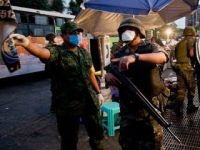New diseases: Are we safe?
The reaction of the World Health Organization to the case of nCoV (Novel Coronavirus Infection) is tellingly similar to the reaction of the WHO to the new strain of Influenza A H1N1 in 2009 - an emulation of the three Sanzaru monkeys covering their eyes, ears and mouths. Do nothing and hope it spreads...

From SARS to SARI. Novel Coronavirus Infection, or nCoV is far less widespread than the Severe Acute Respiratory Syndrome (SARS) which swept across 37 countries from November 2002 to July 2003 causing 775 deaths in 8,273 cases (a fatality rate of 9.6%). However, Novel Coronavirus Infection, causing Severe Acute Respiratory Infections (SARI) has killed nine of the confirmed 16 cases, a fatality rate of 56%.
And as usual, only laboratory tested cases count, meaning that the real prevalence and fatality rate could be far higher, as was the case with the Influenza A H1N1 pandemic in 2009, whose official statistics were a relatively low fatality rate of 0.01 to 0.03% (Influenza usually has a fatality rate of lower than 0.03%) or 294,500 deaths. However, there are claims that up to 579,000 people could have died from A H1N1, as many cases in Africa and South-East Asia (where else?) went unreported.
And as was the case with A H1N1, as is the case with practically all outbreaks and pandemics of disease, what does the WHO do with nCoV? It "encourages all Member States (MS) to continue their surveillance for severe acute respiratory infections (SARI) and to carefully review any unusual patterns", while it is "currently working with international experts and countries where cases have been reported to assess the situation and review recommendations for surveillance and monitoring".
And while the WHO "continues to closely monitor the situation" (split infinitive), it "does not advise special screening at points of entry with regard to this event nor does it recommend that any travel or trade restrictions be applied". Practically a copy-paste of the official position during the A H1N1 pandemic. It is the verborrea of those who spend millions doing nothing.
In four words, sit back, do nothing, or in a four-letter word, zero. And this is the approach of those who are supposed to be protecting us even though the WHO itself admits that "there is insufficient information available to allow a conclusive assessment of the mode and source of transmission". Bullshit! There is telling evidence which points towards a strong possibility of human-to-human transmission on nCoV.
The three apes sanbiki no saru, from Japanese mythology, are called Mizaru (who covers the eyes and can see no evil); Kikazaru (covering his ears, can hear no evil) and Iwazaru (covers his mouth, can speak no evil). Doing nothing, these monkeys hope that a disease will simply go away? Or spread, so that the pharmaceutical giants can make millions?
Is that the idea? If it isn't, it seems like it.
Timothy Bancroft-Hinchey
Pravda.Ru
Subscribe to Pravda.Ru Telegram channel, Facebook, RSS!





